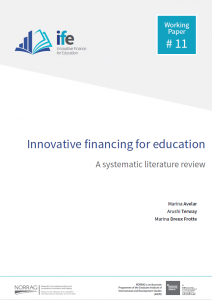NORRAG’s analytical work on Innovative Financing for Education (IFE) aims to develop capacity and deepen collective knowledge about the mounting numbers and modalities of innovative financing mechanisms in the education sector. By conducting research on diverse IF experiences in education, NORRAG, with various partner organisations, is building empirical evidence on the additionality and efficiency of IFE and its impact on the provision, quality, and equity in education.
Innovative financing has the potential to attract additional funds for the education sector while also addressing quality and equity challenges. However, innovative finance is understood in many different ways by development and education stakeholders.
The term “innovation financing” does not have one concrete definition by its nature. Most simply, it means some form of innovation on how financial transactions take place for any purpose. Within the international development sector, the term was initially used after the global commitment to the Millennium Development Goals in the year 2000. Often used interchangeably with “Non-Traditional Financing” or “Alternative Financing”, the international community started exploring innovative financing mechanisms to bring in additional funding to reach the MDGs. Over the years, the innovation has been seen as the creative leveraging “of existing funding and revenue streams, infrastructure, expertise, and networks to generate new and desired impact in the domains of financing, efficiency gains, and reduction of business risk (Filipp & Lerer, 2013).”
NORRAG defines innovative financing as creative financing structures or arrangements that facilitate the movement of funds from sources that are interested in giving funds for a particular purpose to domains or sectors that need funds to carry on their activities. The aim of innovative financing, especially in education is to:
 The NORRAG team conducted a comprehensive literature review of both grey and academic literature on IFE, which included over 150 individual articles. The publication includes an analysis of the types of mechanisms that have been researched, disciplinary approaches, definitions, rationales, along with a discussion on the identified benefits and challenges. A typology and description of the most prevalent innovative financing mechanisms discussed in education will also be published.
The NORRAG team conducted a comprehensive literature review of both grey and academic literature on IFE, which included over 150 individual articles. The publication includes an analysis of the types of mechanisms that have been researched, disciplinary approaches, definitions, rationales, along with a discussion on the identified benefits and challenges. A typology and description of the most prevalent innovative financing mechanisms discussed in education will also be published.
Please contact us: